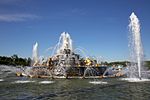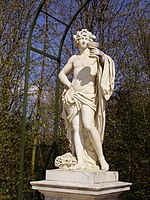The labyrinth of Versailles

The labyrinth of Versailles was a hedge maze in the Gardens of Versailles with groups of fountains and sculptures depicting Aesop's fables. [1] André Le Nôtre initially planned a maze of unadorned paths in 1665, but in 1669, Charles Perrault advised Louis XIV to include thirty-nine fountains, each representing one of the fables of Aesop. [2] The work was carried out between 1672 and 1677. Water jets spurting from the animals mouths were conceived to give the impression of speech between the creatures. There was a plaque with a caption and a quatrain written by the poet Isaac de Benserade next to each fountain. A detailed description of the labyrinth, its fables and sculptures is given in Perrault's Labyrinte de Versailles, illustrated with engravings by Sébastien Leclerc. In 1778 Louis XVI had the labyrinth removed and replaced by an arboretum of exotic trees planted as an English-styled garden.
Excerpt from the Wikipedia article The labyrinth of Versailles (License: CC BY-SA 3.0, Authors, Images).The labyrinth of Versailles
Salle des Cognassiers, Versailles
Geographical coordinates (GPS) Address Nearby Places Show on map
Geographical coordinates (GPS)
| Latitude | Longitude |
|---|---|
| N 48.803611111111 ° | E 2.1166666666667 ° |
Address
Salle des Cognassiers
78000 Versailles, Notre-Dame
Ile-de-France, France
Open on Google Maps









